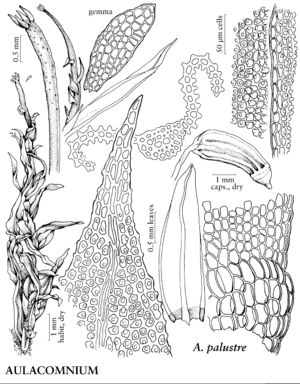Aulacomnium palustre
Sp. Musc. Frond. Suppl. 3(1,1,Aulacomnion): 4. 1827.
Plants to 10 cm, in loose, irregular mats or dense pure cushions, yellow, yellow-green, or brown to blackish when growing suboptimally. Stems yellow, yellowish green, or yellowish-brown; cross-section pentagonal, cortical cells in 4–6 irregular layers, outer medulla cells thicker walled than inner, central strand conspicuous, sometimes degraded; rhizoids between leaves throughout plants, conspicuous when dry or moist, or visible among leaves at base of plants. Leaves distant and not covering rhizoids, or imbricate and rhizoids mostly hidden, undulate, twisted or straight when dry, erect-spreading when moist, broadly to narrowly lanceolate, widest at base, often concave; base not rounded to insertion; margins revolute usually one time, sometimes more, in proximal 2/3, irregularly serrulate at apex; apex acute, acuminate, or narrowed, rounded, and somewhat cucullate; costa flexuose; laminal cells rounded-quadrate, short-rectangular, or elliptic, papillae large; basal-cells often 2-stratose at insertion, walls brown. Specialized asexual reproduction by bullet or spearpoint-shaped propagula, flat at attachment, in terminal cluster. Perigonia as terminal discoid splash platforms; paraphyses of 8–12 cells. Perichaetia with paraphyses absent. Seta 3–5 cm. Capsule inclined to horizontal, 3–4 mm; operculum short-rostrate, rostrum blunt; endostome cilia nodose. Spores 10–15 µm, smooth.
Habitat: Wet habitats, fens, marshes, swamps, peat, organic soil, moist to wet mineral soil, rock
Elevation: low to high elevations
Distribution

Greenland, Alta., B.C., Man., N.B., Nfld. and Labr., N.W.T., N.S., Nunavut, Ont., P.E.I., Que., Sask., Yukon, Ala., Alaska, Ariz., Ark., Calif., Colo., Conn., Del., Fla., Ga., Idaho, Ill., Ind., Iowa, Kans., Ky., La., Maine, Md., Mass., Mich., Minn., Miss., Mo., Mont., Nebr., Nev., N.H., N.J., N.Mex., N.Y., N.C., N.Dak., Ohio, Okla., Oreg., Pa., R.I., S.C., S.Dak., Tenn., Tex., Utah, Vt., Va., Wash., W.Va., Wis., Wyo., Mexico, West Indies (Dominican Republic), n, w South America, Europe, Asia, Pacific Islands (New Zealand), Australia
Discussion
Aulacomnium palustre is essentially a Northern Hemisphere moss, widespread in North America, but not necessarily common throughout its range; it may be introduced in New Zealand. Numerous varieties and forms have been proposed and sometimes recognized to accommodate the range of morphological variation present in this moss (G. Sayre 1935; W. Kabiersch 1937). None of these infraspecific concepts are adopted here in the absence of thorough studies employing modern techniques. A distinctive alpine expression (var. imbricatum Bruch & Schimper) has been recognized in Colorado and elsewhere (W. A. Weber and R. C. Wittmann 2007). In such plants, the leaves cover most of the rhizoids but are narrowly lanceolate and widest near the base; this is also true in lowland expressions of A. palustre, where some populations can also have the narrowly rounded leaf apices of var. imbricatum. The leaves of this species are weakly plicate, and the costa surface cells are large and hyaline. The basal laminal cells of the inner perigonial leaves are large and smooth; the 4 or 5 distal cells are short and wider than the longer, more proximal cells. The perichaetia are in the form of splash cups.
Selected References
None.
